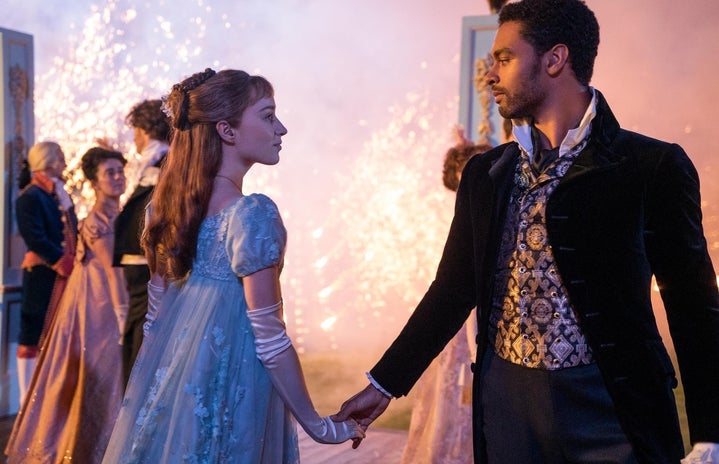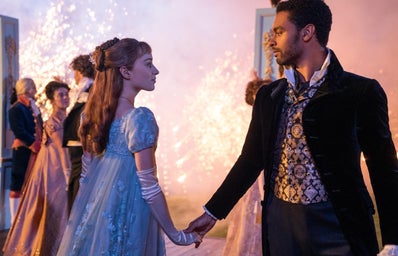The period drama has always played a central role in the media typically consumed by women. The genre was popularized by original novels from authors like Jane Austin and the Brontë sisters, just to name a few. Far from its original form in the 18th century, modern period dramas have evolved into beloved films and television series, such as Pride & Prejudice, Becoming Jane, Downton Abbey and of course Bridgerton. What is it about these dramas that keep them so alluring? Is it escapism, historical intrigue or both? And how did Bridgerton do such a good job revolutionizing the genre despite its criticisms?
What makes a period drama? For starters, pieces must be set in a significant time period well before our own. The most famous period dramas are usually set in Europe, or in the USA and as such the majority of period dramas are led by white characters. Secondly, the plot should revolve around romantic or familial relationships. And as a result, romance and heartache are typical in the period drama. Period dramas also predominantly focus on characters that are considered to have higher status, whether it be because of their family’s wealth, royal blood or even the characters’ own exceptional talent or intellect.
So why do we keep coming back to these stories, even if the narrative has been told over and over again? Historical fiction is most akin to ‘realistic fantasy’ it’s for those who want a fantastical experience without the story having to introduce fantasy creatures or magic. For people who want to escape, but not to someplace completely out of this world. Despite this, people who enjoy Harry Potter or Game of Thrones are also likely to enjoy historical dramas as they can be seen as being cut form the same cloth in terms of the seemingly fantastical locations, such as castles, the extravagant costuming especially for the more regal and high-class characters as well as the total tonal shift from shows which focus more heavily on realism. According to Drama.uktv, period dramas also invoke a sense of nostalgia by romanticizing certain time periods with the choice of music, clothing and even the food. Period dramas excel in bringing us unforgettable romance stories, solidifying these stories as classics in mainstream media. Take Lady Mary Crawley and Matthew Crawley from Downton Abbey for example or the even more classic, Elizabeth Bennet and Mr. Darcy from Pride & Prejudice. The plotlines of period dramas, especially those that are serialized, are incredibly intricate, leaving us intrigued and wanting more.
Bridgerton, like many other period dramas, started as a novel series written by Julia Quinn. The series follows the eldest daughter of the powerful Bridgerton family, Daphne, as she enters the highly competitive marriage market of Regency-era London. Not long after, she bumps into the most eligible bachelor in town, the Duke of Hastings Simon Basset, initiating the meet-cute and establishing the romantic journey the audience will thus follow.
Described as the new ‘Historical Gossip Girl’ by Daily Mail, they go on to explain how some viewers criticized the show for “its ‘wooden’ acting and ‘boring’ plot.” The show was further criticized for using lavish costumes and classically reworked pop songs in the score to mask the plot’s insecurities. The biggest controversy however was the alleged female-on-male rape scene which many viewers believed was “glossed over.” Lizzy Talbot, intimacy coordinator for Bridgerton, however believes that the scene “created a really great conversation around consent. And what it looks like, regardless of gender.” But also had fans questioning the morals of the show using rape as a plot device. In defense of the backlash received from the scene, Chris Van Dusen, explained how he wanted Daphne to be portrayed as a “flawed” character that “makes questionable choices”, if rape can even be narrowed down to a simple “questionable choice” that is. Although this scene did bring up conversations about female-on-male rape, we hope the creators will think twice about the reckless inclusion of these kinds of subjects, especially when used to create three-dimensionality in a character. This, along with the colour-conscious casting, sets Bridgerton aside from other period dramas, solidifying its place in the present post-#MeToo and inclusivity-minded world we live in. According to Julia Quinn herself in an interview with OprahDaily she was all for the multiracial cast, calling the casting “thoughtful”, making the world of Bridgerton “much more diverse and inclusive.” The multiracial casting was also completely accurate to the historical figures of the time as Queen Charlotte, the actual wife of King George III, was mixed race and of African descent. The casting shook the norms of past period dramas all-white casts by not only casting characters of varied races but of equal importnance.
Whether you love them or hate them period dramas will always hold a popular place within film, series and literature. However, the challenge that creators must now face is how to bring these period dramas into the 21st century; by keeping the fundamentals of the genre while creating pieces relevant to world we currently live in. In my opinion, it seems like Bridgerton is a great place to start.


